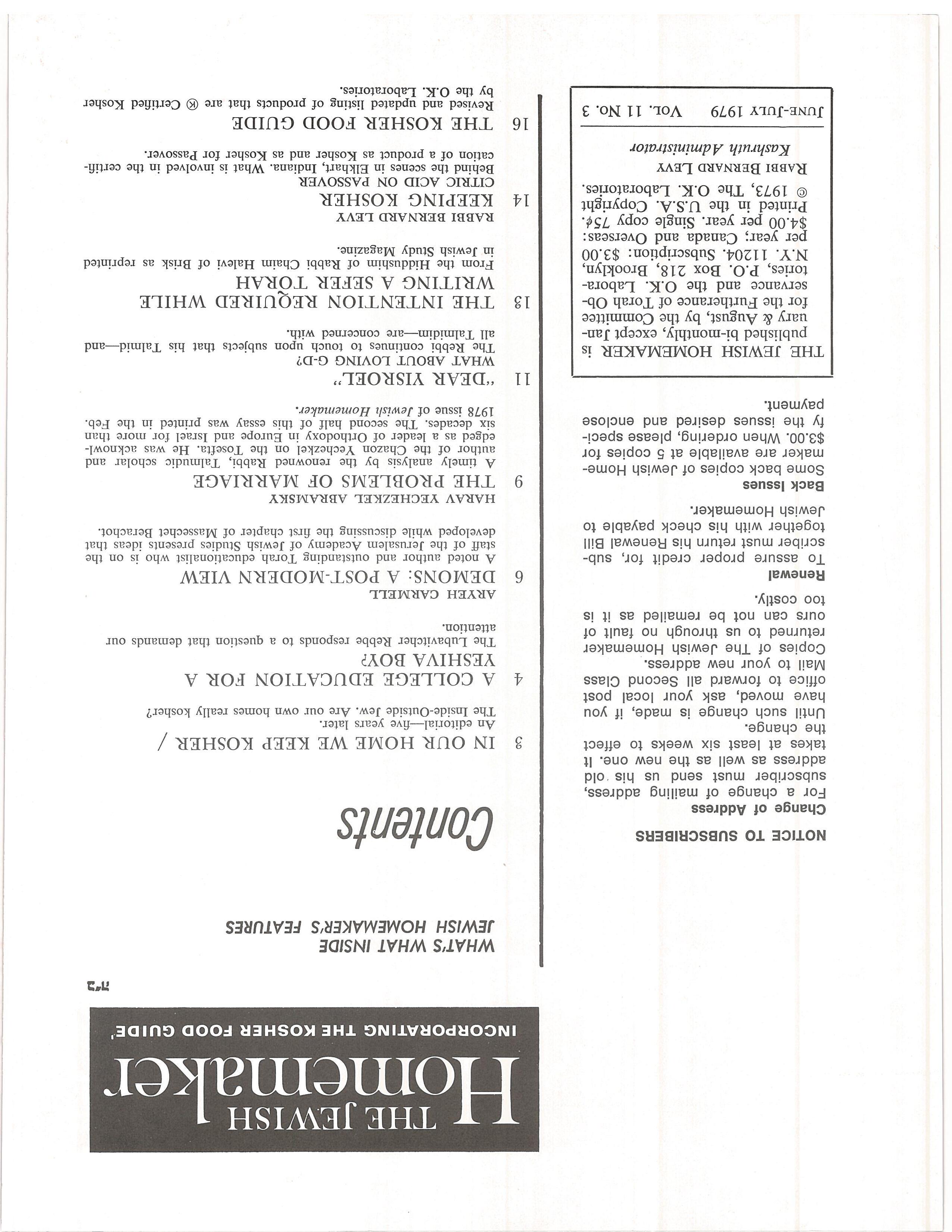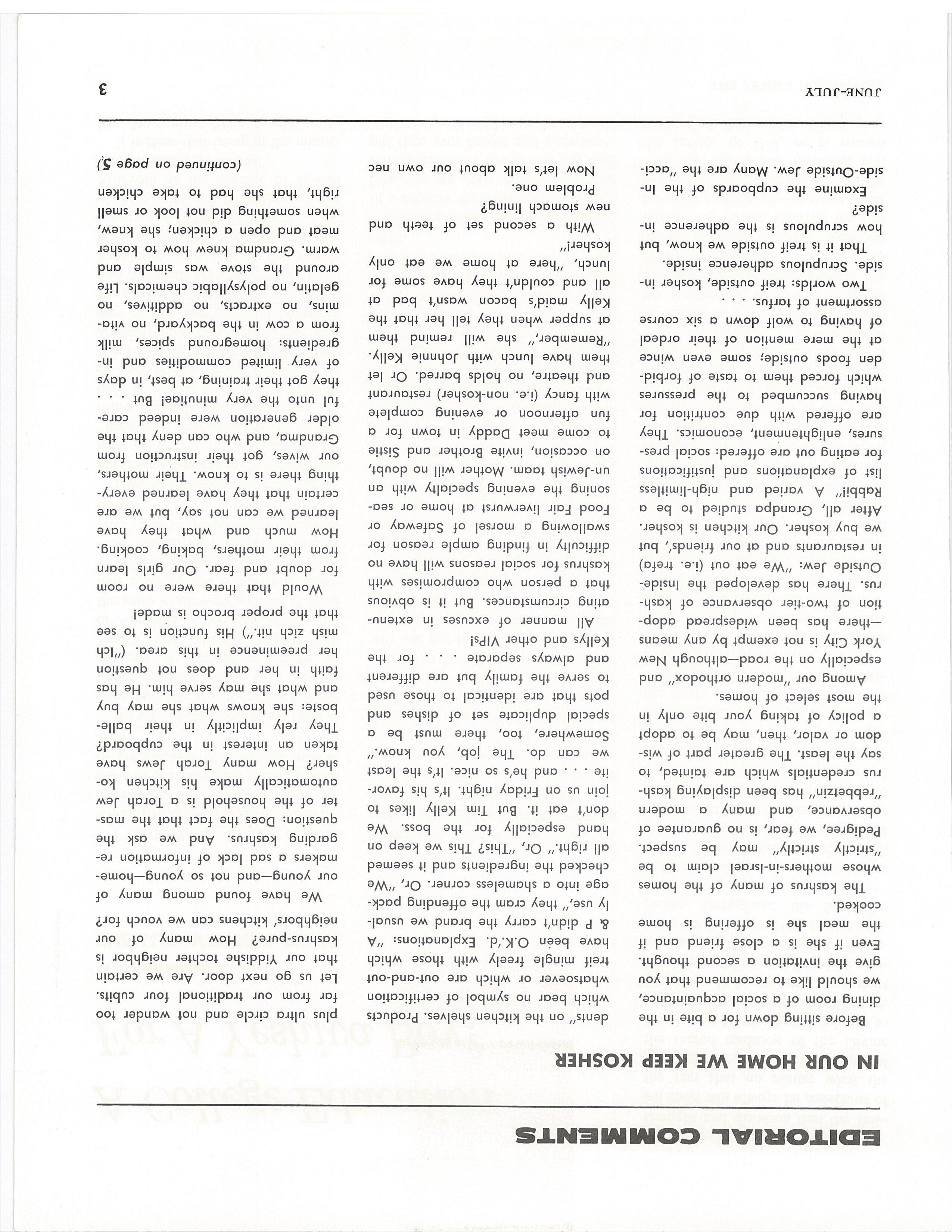
4 minute read
THE JEWISH omema er
INCORPORATING THE KOSHER FOOD GUIDE’
WHAT’S WHAT INSIDE JEWISH HOMEMAKER’S FEATURES
Advertisement
Content
3 IN OUR HOME WE KEEP KOSHER / An editorial—five years later. The Inside-Outside Jew. Are our own homes really kosher?
4 A COLLEGE EDUCATION FOR A YESHIVA BOY?
The Lubavitcher Rebbe responds to a question that demands our attention.
ARYEH CARMELL
6 DEMONS: A POST-MODERN VIEW
A noted author and outstanding Torah educationalist who is on the staff of the Jerusalem Academy of Jewish Studies presents ideas that developed while discussing the first chapter of Massechet Berachot.
HARAV YECHEZKEL ABRAMSKY
9 THE PROBLEMS OF MARRIAGE
A timely analysis by the renowned Rabbi, Talmudic scholar and author of the Chazon Yechezkel on the Tosefta. He was acknowl edged as a leader of Orthodoxy in Europe and israel for more than six decades. The second half of this essay was printed in the Feb. 1978 issue of Jewish Homemaker.
11 “DEAR YISROEL”
WHAT ABOUT LOVING G-D?
The Rebbi continues to touch upon subjects that his Talmid—and all Talmidim—are concerned with.
13 THE INTENTION REQUIRED WHILE WRITING A SEFER TORAH
From the Hiddushim of Rabbi Chaim Halevi of Brisk as reprinted in Jewish Study Magazine.
RABBI BERNARD LEVY
14 KEEPING KOSHER CITRIC ACID ON PASSOVER
Behind the scenes in Elkhart, Indiana. What is involved in the certifi cation of a product as Kosher and as Kosher for Passover.
16 THE KOSHER FOOD GUIDE
Nor 0 E E Eepkosher
Before sitting down for a bite in the dining room of a social acquaintance, we should like to recommend that you give the invitation a second thought. Even if she is a close friend and if the meal she is offering is home cooked.
The kashrus of many of the homes whose mothers-in-Israel claim to be “strictly strictly” may be suspect. Pedigree, we fear, is no guarantee of observance, and many a modern “rebbetzin” has been displaying kash rus credentials which are tainted, to say the least. The greater part of wis dom or valor, then, may be to adopt a policy of taking your bite only in the most select of homes.
Among our “modern orthodox” and especially on the road—although New York City is not exempt by any means —there has been widespread adop tion of two-tier observance of kash rus. There has developed the InsideOutside Jew: “We eat out (i.e. trefa) in restaurants and at our friends’, but we buy kosher. Our kitchen is kosher. After all, Grandpa studied to be a Rabbi!” A varied and nigh-limitless list of explanations and justifications for eating out are offered: social pres sures, enlightenment, economics. They are offered with due contrition for having succumbed to the pressures which forced them to taste of forbid den foods outside; some even wince at the mere mention of their ordeal of having to wolf down a six course assortment of tarfus.
Two worlds: treif outside, kosher in side. Scrupulous adherence inside.
That it is treif outside we know, but how scrupulous is the adherence in side?
Examine the cupboards of the In side-Outside Jew. Many are the “acci dents” on the kitchen shelves. Products which bear no symbol of certification whatsoever or which are out-and-out treif mingle freely with those which have been O.K.’d. Explanations: “A & P didn’t carry the brand we usual ly use,” they cram the offending pack age into a shameless corner. Or, “We checked the ingredients and it seemed all right.” Or, “This? This we keep on hand especially for the boss. We don’t eat it. But Tim Kelly likes to join us on Friday night. It’s his favor ite and he’s so nice. It’s the least we can do. The job, you know.” Somewhere, too, there must be a special duplicate set of dishes and pots that are identical to those used to serve the family but are different and always separate for the Kellys and other VIPs!
All manner of excuses in extenu ating circumstances. But it is obvious that a person who compromises with kashrus for social reasons will have no difficulty in finding ample reason for swallowing a morsel of Safeway or Food Fair liverwurst at home or sea soning the evening specialty with an un-Jewish taam. Mother will no doubt, on occasion, invite Brother and Sistie to come meet Daddy in town for a fun afternoon or evening complete with fancy (i.e. non-kosher) restaurant and theatre, no holds barred. Or let them have lunch with Johnnie Kelly. “Remember,” she will remind them at supper when they tell her that the Kelly maid’s bacon wasn’t bad at all and couldn’t they have some for lunch, “here at home we eat only kosher!”
With a second set of teeth and new stomach lining?
Problem one.
Now let’s talk about our own nec plus ultra circle and not wander too far from our traditional four cubits. Let us go next door. Are we certain that our Yiddishe tochter neighbor is kashrus-pure? How many of our neighbors’ kitchens can we vouch for?
We have found among many of our young—and not so young—home makers a sad lack of information re garding kashrus. And we ask the question: Does the fact that the mas ter of the household is a Torah Jew automatically make his kitchen ko sher? How many Torah Jews have taken an interest in the cupboard? They rely implicitly in their balle boste: she knows what she may buy and what she may serve him. He has faith in her and does not question her preeminence in this area. (“Ich mish zich nit.”) His function is to see that the proper brocho is made!

Would that there were no room for doubt and fear. Our girls learn from their mothers, baking, cooking. How much and what they have learned we can not say, but we are certain that they have learned every thing there is to know. Their mothers, our wives, got their instruction from Grandma, and who can deny that the older generation were indeed care ful unto the very minutiae! But they got their training, at best, in days of very limited commodities and in gredients: homeground spices, milk from a cow in the backyard, no vita mins, no extracts, no additives, no gelatin, no polysyllabic chemicals. Life around the stove was simple and warm. Grandma knew how to kosher meat and open a chicken; she knew, when something did not look or smell right, that she had to take chicken
(continued on page 5)







